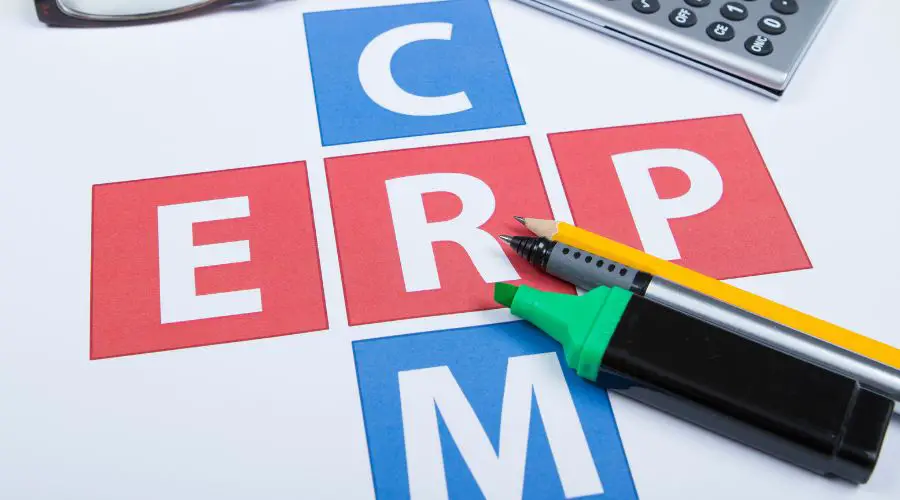CRM and ERP are both essential components of a company’s digital transformation. While ERP is the financial backbone or the “brains” of an organization, CRM is its customer-facing arm.
So, why do these components need to be integrated? This article will explore this concept, with a summary of the benefits of integrating your CRM and ERP systems, as well as the challenges many companies face.
Table of Contents
- What is CRM?
- What is ERP?
- How to integrate CRM with ERP?
- What are the benefits of integrating CRM with ERP?
What is CRM?
CRM is an acronym for Customer Relationship Management. It is a software solution that helps businesses to manage customer relationships in one place.
For example, CRM software manages all your contacts with customers and prospects, helping you to generate more business opportunities through better customer service.
Most companies use some form of a CRM to manage customer relationships, but there are many different types of CRM software.
What is ERP?
ERP is an acronym for Enterprise Resource Planning. It is a type of software that helps organizations manage their finances, inventory and other key backend data.
For example, ERP solutions also cover order management, supply chain management and service-related information.
In addition, many ERP systems offer Human Resources Management Systems (HRMS), built-in CRM tools and ecommerce capabilities.
The primary goal of ERP software is to bring all company processes under one roof so that they can be run efficiently and effectively.
By uniting these disparate functions into one system, businesses can streamline their operations and improve their bottom line.
While the implementation of an ERP system can be a complex process, the long-term benefits are well worth it.
How to integrate CRM with ERP?
Integrating CRM with ERP can be a difficult task, but it is important to do in order to achieve the benefits of both systems.
There are several things to consider when integrating the two systems, including deciding what type of integration is needed and ensuring that unnecessary complexity is avoided.
It is also important to choose a platform that will support all of the integration needs of your business.
A unified platform is essential for any successful ERP integration strategy, whether it’s enterprise B2B integration, application integration, SaaS integration, or big data integration.
What are the different types of CRM and ERP integrations?
CRM and ERP integrations are the different methods of connecting CRM software with Enterprise Resource Planning software. Some integrations include:
1. Data Transfer: This is the simplest form of integration between two systems, where data can be transferred from one system to another without any changes in either system. For example, if you want to transfer data from your CRM system to your ERP system, you just need to extract the data from one and put it into another.
2. Data Synchronization: In this type of integration, data transfer is not possible. Instead, the two systems are synchronized with each other in real-time so that they can share and update the same information without any changes in either system.
3. Data Transformation: In this type of integration, data is extracted from one system and transformed into a format that can be used by another system. For example, if you have an ERP system that does not support data in a format required by your CRM system, you can use an ETL (“Extract, Transform and Load) tool to transform the data before putting it into the ERP system.
4. Data Consolidation: In this type of integration, data from multiple systems is consolidated into a single system. For example, if you have two ERP systems and want to consolidate the information from both these systems into a single system, you can use an ETL tool to consolidate the data from both systems into a single database.
5. Data Replication: In this type of integration, data is replicated from one system to another. For example, if you have an ERP system and want to replicate the data from this system into a CRM application, you can use ETL tool for data replication.
What are the Challenges when integrating your CRM and ERP systems?
The concept of integrating these systems makes sense, but there are several challenges companies face when undergoing integration, including:
- Integration complexity
- Data quality issues and data migration
- Lack of support for integration in the software development life cycle (SDLC)
- Lack of a single point-of-view for customer data across the enterprise
It’s not a simple process, and there are a lot of moving pieces to make sure you do it properly, efficiently and thoroughly.
For example, In order to overcome these challenges, companies should consider a multi-vendor approach when choosing their CRM and ERP systems.
By using multiple vendors for different components of the overall solution, companies can avoid vendor lock-in and ensure that their systems will work together seamlessly.
Once you have the right partners and tools in place, as well as a cohesive plan, there are many benefits to following through on ta CRM/ERP integration.
What are the benefits of integrating CRM with ERP?
When two systems are integrated, it allows for a more seamless flow of data between them.
In the case of CRM and ERP, this means that sales and marketing teams can get real-time information about customers.
This helps them to modify their tactics on the fly, in order to improve customer satisfaction. Additionally, having immediate access to customer data can help reduce operational costs by preventing or solving customer issues before they become bigger problems.
But perhaps the best benefit of integrating CRM with ERP is that it establishes a link between the two teams.
This linkage can result in increased communication and coordination, as well as better decision-making.
All of these benefits lead to one thing: satisfied customers who keep coming back!
To recap, here are 6 proven benefits to integrating your CRM and ERP systems :
1. Improved customer service and satisfaction: Customers are always changing, so your company needs to be able to change with them. By having access to better data about customers, you can better anticipate their needs and desires. This can lead to better customer service, which in turn leads to higher satisfaction rates.
2. More accurate forecasting: Forecasting is one of the most important aspects of any business. By integrating your CRM and ERP systems, you can have more accurate data about customer behavior patterns. This allows for better forecasting, which leads to a stronger bottom line.
3. Improved customer loyalty: The more you can do for your customers, the better they will like you! By being able to anticipate their needs, provide them with more personalized services and make their lives easier, you will be able to build customer loyalty.
4. Reduced costs: Integrating your CRM and ERP systems can help streamline your business processes and eliminate redundancies. This will help you reduce costs, increase efficiency and improve productivity.
5. Better decision-making: By having access to accurate information about your customers, sales and operations, you will be able to make better decisions. You will also be able to identify trends and patterns, enabling you to plan ahead for future growth.
6. Improved employee productivity: By integrating CRM and ERP, you will be able to give your employees access to information about customers, sales and operations. This will help them make better decisions faster – becoming more efficient – and enable them to provide high-quality service to customers and increase productivity.
Integrating your CRM with an ERP system is a powerful way to improve customer service, employee productivity and overall business performance.
You can also improve your business processes and reduce costs. So, what are you waiting for?

